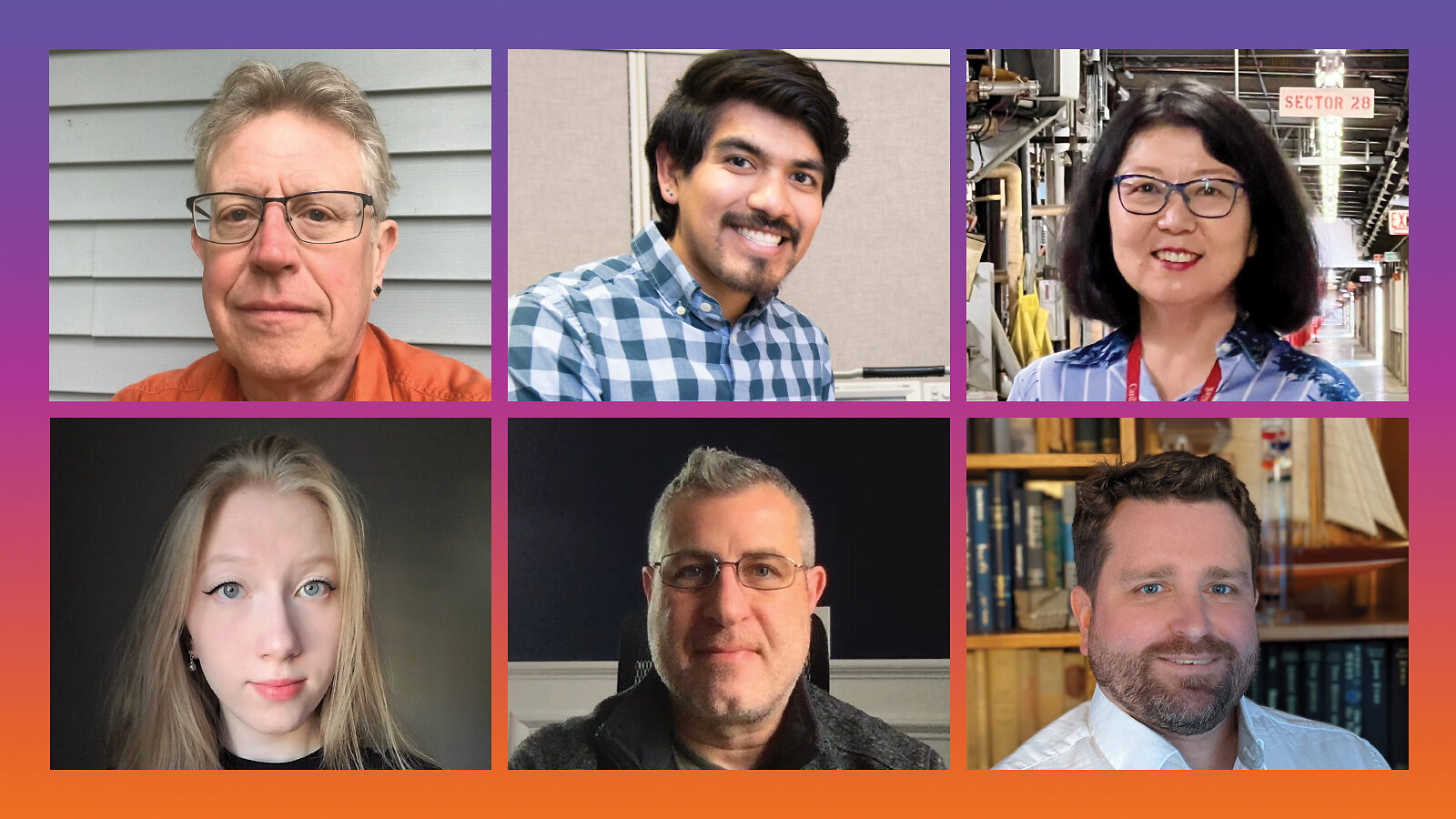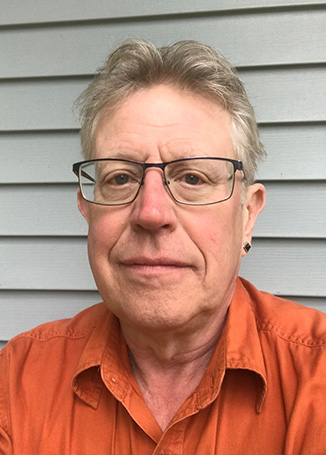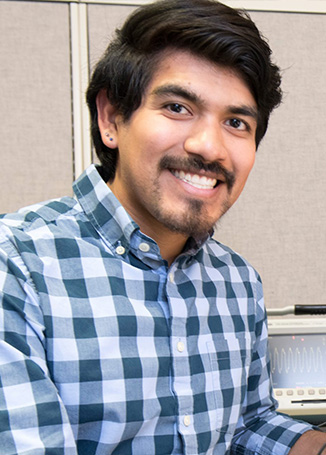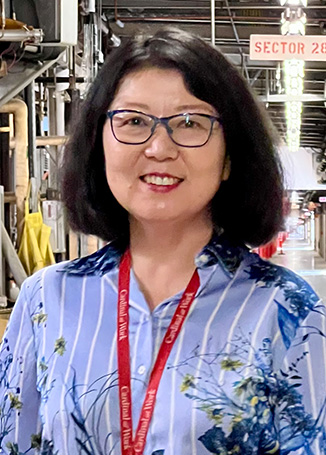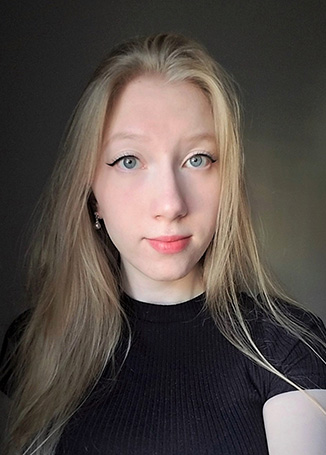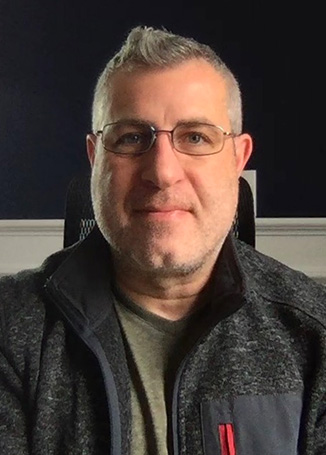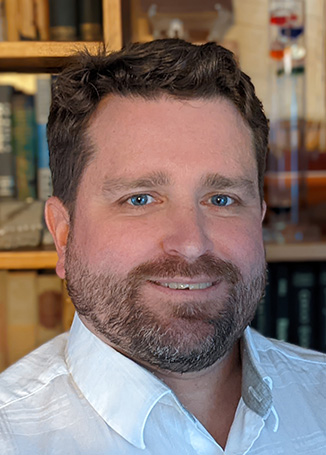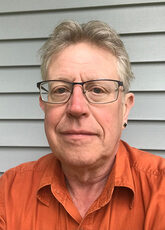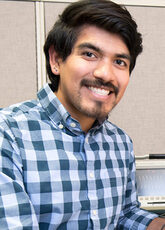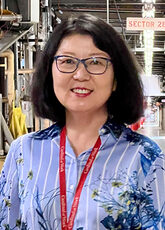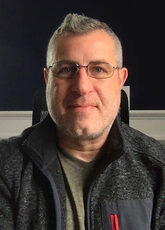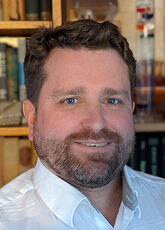Earning a doctoral degree is just one way to begin a career in physics. Meet six people who make crucial contributions to particle physics research, without a PhD.
Ronald Richards
Mechanical engineer at Michigan State University
Ronald Richards’ father was a mechanical engineer for Ford Motor Co., and as a child in the 1960s, Richards spent countless hours in their home shop with him, taking machines apart to see how they worked. His father gave him an old Fordson ignition coil to play with, and Richards would create big sparks with it. “You can’t hurt yourself, but you don’t want to do it very often,” he says with a laugh.
That ignition coil experience ultimately got him his first job in physics.
As an undergraduate industrial design student at Michigan State University, he was hired by the physics department to help make pieces for the E-594 neutrino detector at the US Department of Energy’s Fermi National Accelerator Laboratory. “At my high school, I was the only nerd in the machine shop that had taken all of the science classes, too,” he says. “I was a science geek.”
When the high-voltage distribution system in the E-594 detector at Fermilab caught on fire one day, Richards was the one who knew how to redesign the voltage system to prevent it from happening again. “Because playing with that coil as a kid, I knew you needed to give the system a lot of room,” he says. “And that got me hired.”
From there, Richards spent his career in particle physics, creating new machines and parts for some of the field’s biggest experiments at Fermilab and CERN. When a team ran into a problem that didn’t have an existing solution, they turned to Richards. He designed and built a plastic fiber-optic welder to create readout assemblies for scintillators, for example, and developed a special drilling machine to help assemble the ATLAS detector. Over the span of a decade, his job took him many times to CERN in Europe, where his work got him cited in scientific publications.
“It’s kind of fun when you get to make something really clever that works, and then later someone higher up on the chain says, ‘Oh, you did that? That was pretty good.’” he says. “But any mechanical job is fun for me.”
Working with physicists, he learned to speak their language, and, when at the labs, he looked forward to getting together with everyone at the end of the day to solve problems over beer and food. He never considered his career path—he just kept doing the job he wanted to do, and new opportunities always presented themselves.
“It’s funny that in the heart of a research community, the exact degree one has does not always mean much,” he says. “If they’ve got someone who is reasonable and who can do the job, they will just keep feeding them things to do.”
These days he is retired but still has his own machine shop, where he plans to create non-figurative sculptures. To those considering following in his footsteps, he recommends getting a job with a university—Michigan State University was his employer throughout his career—and enjoying finding solutions to each new problem.
"I got a job that made me happy, and with each project I just had fun,” he says.
Miguelangel Marchan
Electrical engineer at Fermilab
Miguelangel Marchan had always been good at math, but when the director of a research program he was a part of at Northern Illinois University suggested that he apply for an internship at Fermilab, he demurred.
“Fermilab is for geniuses, and I’m not a genius,” he says he remembers thinking at the time.
But the director made him pinkie promise to apply, so he did. That ultimately led him to four internships with the lab—two during his undergraduate program in electrical engineering at NIU and two during his master’s program in electrical engineering at University of Illinois Chicago.
“In my life, I have always been scared to apply for things because I think I am not good enough,” he says. “But the advice I would give to someone is to just apply, even if you are afraid, because the worst-case scenario is that you don’t get it.”
The internships gave him tastes of different work done at the lab. As an undergraduate, he worked in the Office of Partnerships and Technology Transfer, working with scientists on patents for their inventions. As a master’s student, he worked in the electrical engineering department—and that’s where he discovered his passion. “I thought, this is the place for me,” he says. “The environment was amazing. I could always walk down the hall and ask someone for help. Sometimes a physicist would give me a 15-minute lesson on something. For my career and my own knowledge, I think that’s awesome.”
When he finished his degree, he applied to Fermilab once again, this time for a permanent position. Now he works in the Detector Electronics Group, where he designs and tests circuit boards that conduct the readout for detectors.
He says each day is different: Sometimes he tests circuit boards, sometimes he investigates why a circuit board broke, and sometimes he works with physicists to set up experiments. Right now, he works mostly on the international Deep Underground Neutrino Experiment, consulting with physicists and technicians on testing and modifications. He collaborates with physicists around the world, sending circuit boards to Colombia and Italy to make sure they work correctly in the field.
Though his department is small, he says when he joins DUNE collaboration meetings—which include physicists, programmers and mechanical engineers—he understands that what they do is integral to a huge, exciting project.
“The physicists are brilliant and smart, and I really respect what they do; but they are down-to-earth people, and I don’t feel intimidated,” he says. “We are all working together toward the same goal.”
He has also become a part of the Vamos a Fermilab program, an outreach program to create an inclusive climate for Hispanic or Latinx individuals pursuing STEM careers. Through the program, he will mentor a college student—and will encourage them to apply for opportunities, like he did.
Bo Hong
Electronic engineer at SLAC
When Bo Hong was an electronics engineering student at Southeast University in China in the 1980s, one alumna was lauded as a national hero: Chien-Shiung Wu, a Chinese American physicist who worked on the Manhattan Project. Later, Wu conducted experiments that made the Nobel Prize-winning discovery that parity is not conserved.
Hong was dazzled by Wu’s achievements and was drawn to the idea of using scientific thinking in her career. But when staff from China’s Institute of High Energy Physics came to the school to hire an engineer, they told the administration they only wanted to hire a male graduate.
“But the school said, ‘If you want to have one man, you have to have one woman, too,’” Hong says, and the school put her forth as the top candidate.
Hong was hired, and she spent the next 16 years at the lab, doing work on the particle accelerator, including developing an electron gun for the beam line.
In the early 1990s, a scientist from SLAC National Accelerator Laboratory came and gave a presentation at the lab. In the audience, Hong realized she disagreed with one of his statements, so she stood up and said so. “That caught his attention,” she says. “I realized that in this field, you have to express yourself and be assertive.”
Ultimately, that same scientist recruited her to SLAC in 2001, where she shifted to working on low-level radiofrequency. She helped design and develop the Linac Coherent Light Source, which takes X-ray snapshots of atoms and molecules at work.
“Physicists come up with ideas but need help realizing them,” she says. “Part of my job is to understand what they need and then make those ideas a reality.”
Now she spends much of her time designing and simulating systems for experiments. Her favorite part is presenting her ideas to the scientists she works with, and helping shape one of the best machines of its kind in the world.
In a national laboratory environment, advanced degrees are commonplace, and Hong is in the minority with no advanced degree. “Even if you have a PhD, your knowledge must still evolve quickly in this modern world,” she says. “It’s more about getting the training to learn how to learn, because that never ends. When there is an achievement in physics that your machine is a part of, you still have pride and know that you are one of them.”
Ashley Getsie
Accelerator operator at Fermilab
Many physics undergraduates feel the pressure to get a PhD because they are told that is the only way to begin a career path in the field. Ashley Getsie had heard that, too. “It’s almost like you’re expected to do it,” she says.
But when she graduated with a physics degree from Rensselaer Polytechnic Institute in 2020, she knew she was ready to take a break from academia and start a job in particle physics.
Getsie had always been interested in the big questions in physics—ever since she had watched NOVA episodes on television as a kid, learning about the origins of the universe—and had her mind set on working at a national lab. When she saw the opening for a particle accelerator operator at Fermilab, she was excited but hesitant; accelerator operators are the first line of defense for anything that goes wrong within the accelerator complex.
When she took the job, she found out just how much fun that could be. “When something goes wrong, we troubleshoot and diagnose,” she says. “It really feels like you are a detective trying to figure out how the pieces all come together.”
Operators rotate between day, evening and night shifts, monitoring the intensity, position, shape and size of beams the accelerator is providing to several experiments at a time. Oftentimes during overnight shifts, they fine-tune machines to cut down on beam losses. “It makes you feel like you are an important part of something that even when no one else is here, you’re still the ones keeping everything running,” she says.
During the day, the main control room is filled with physicists, scientists and engineers who are working on experiments. “You get to interact with so many different people,” she says. “Most of them are gracious and really like to teach you things that they know.”
Getsie also gets to celebrate when exciting results are achieved, like the first measurements from the Muon g-2 experiment.
“I don’t know of any other job that is involved in so many different experiments,” she says. “It’s really good if you’re coming out of college and trying to figure out what you want to specialize in within the particle physics community.”
There is room for growth in the field as well. Many operators go on to supervise teams, become technicians in other groups, or become engineering physicists. Right now, Getsie is happy to be on the operations team, learning from everyone around her, and says she will let her career grow organically.
“There are a lot of jobs out there with just a bachelor’s degree,” she says. “And if you decide to, you can always go back to school at some point.”
Many physics graduates she has met have worked for a few years before going back to get a graduate degree, often with the help of a lab’s or a company’s tuition assistance program.
“There’s also people who just stay with a bachelor’s degree and still go on to do great things,” she says. “You can do something you really love and that is very fulfilling.”
John De Stefano Jr.
Engineer for IT services and systems at Brookhaven National Laboratory
Like many kids his age in the 1980s, John De Stefano Jr. spent countless quarters on the arcade game Pac-Man, trying to master the movement patterns he needed to eat all the dots and advance to the next level.
As video games moved from arcades to computers to home consoles, he began to think of them not just as entertainment tools, but as systems of visual perception and interaction. That sort of thinking ultimately led him to his job as an engineer at Brookhaven National Laboratory, where he helps create and maintain the IT services and systems that help physicists and other scientists perform the analyses, simulations and calculations that fuel their observations and discoveries.
But it was “quite some time” before he found that path. Out of high school, he worked at a warehouse, until a wooden platform he was standing on broke. By catching himself as the platform fell, he injured his rotator cuff. Out of work after surgery to repair his shoulder, he entered a pre-med program, thinking he could help others rehabilitate after surgery as well. But it didn’t hold his attention, so he switched to an English major with a minor in computer science.
After graduating, he became a technical writer at a telecommunications company and an instructional designer for corporate training software. It was only then that he found his way to a job as an engineer at BNL.
“This seemed to me like an organic progression,” he says. “I learned enough about several technologies to be able to write about and teach them well, until I could eventually transition from writing into managing those technologies.”
These days, he is part of the Scientific Data and Computing Center at Brookhaven, where he is responsible for multiple IT services and systems, working with many PhDs in physics and computer science. His days are spent coordinating with colleagues and team leaders, occasionally coding or installing hardware in the lab. “I enjoy helping people, learning new things, and overcoming challenges, and this field provides an abundance of all of these,” he says. “It also provides its share of frustration—things break, politics obstruct, agendas clash at times—but navigating difficulty is a necessary component of any field of work.”
When it comes to career success in national laboratories that work in physics, he says, dedication, excitement and passion are even more important than high-level education and training. “Education can be obtained in many ways, especially in fields that specialize in technology, and it should be considered a tool, not an obstruction that prevents good, capable, enthusiastic people from contributing to the success of any team.”
Ryan Herbst
Division director at SLAC
In the mid-1990s, Ryan Herbst did not wait to finish his degree in electrical engineering before joining the telecom industry. His father, an airline mechanic, was a self-taught computer programmer, and Herbst had spent his teenage years goofing around with electronics kits, creating little radios and sensors while learning to program in BASIC.
For several years, he worked for both established companies and young startups in Silicon Valley. But eventually, the excitement wore off.
“At the time, I wasn’t interested in a career in research, but after a while, the telecom industry did not offer a lot of interesting R&D challenges,” he says.
Having grown up in the Bay Area, he was familiar with SLAC National Accelerator Laboratory. On a whim he applied—and got—an engineering job there.
He was surprised: His group, though part of a large lab, was small and dynamic and felt more like a startup than a small piece of an organization. He developed testbeds for electronics and worked on software and hardware, including a data acquisition system for the EXO experiment, which searched for neutrinoless double beta decay. He also helped test the application-specific integrated circuit for the Silicon Detector, or SiD, designed to record the trajectories of charged particles produced by the proposed International Linear Collider, and learned how to assemble photon cameras for the Linac Coherent Light Source.
“It was all just very exciting and new for me. There were always cool things going on, and a lot of science I truly didn’t understand,” he says. “But it was great working with the scientists and having them explain it to me, and then I could help solve instrumentation problems.
“I’ve worked two doors down from a Nobel Prize winner. It was a little overwhelming at first. When I worked in industry, people with PhDs were very quick to point that out, but here, it wasn’t something that was pointed out.”
He ultimately became director for the Instrumentation Division and now leads a team of 55 engineers, firmware designers, sensor scientists and assembly workers. The team is responsible for sensors, ASICs, board design and firm design. Each day is different—when a project is done, they all move onto the next project—but he says it can be fun when world-changing results from the lab make the news.
“Sometimes when a publication comes out on a scientific experiment, you can explain to other people that you were a part of that,” he says. “When I started out, I didn’t see my career going here.”
Now, he hires team members—many without PhDs—and encourages his daughter with the same STEM projects his dad showed him. “It’s important to foster this kind of mindset in kids who have aptitude for it, and let them explore, rather than encouraging them to try to climb a ladder or hit checkpoints in their education or career,” he says.



